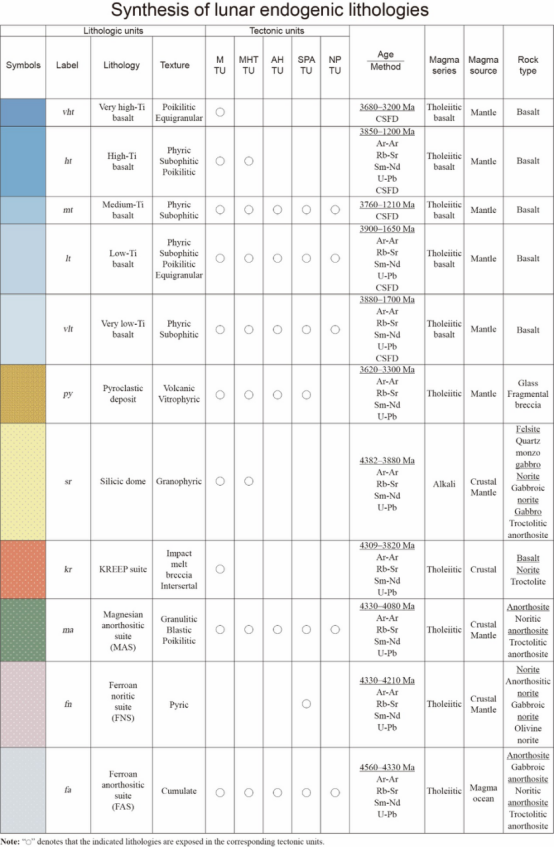In a short communication published in Science Bulletin on Oct. 31, 2022, a team of scientists from Shandong University, Chinese Academy of Sciences, Jilin University, Chinese Academy of Geological Sciences, and China University of Geosciences (Beijing), present a global lithologic map of the Moon at a 1:2,500,000 scale (Figure 1), which is fruit of efforts from dozens of researchers in the past decade (2012-2022).

Figure 1 Thumbnail of the lithologic map of the Moon at a 1:2,500,000-scale
Scientific knowledge of lunar lithologies was first acquired in the 1960s–1970s. Utilizing datasets from numerous manned and robotic lunar exploration missions, the first series of lunar geologic maps was prepared and published by the United States Geological Survey. The definition of lunar geological features in these maps was mostly based on morphological characteristics but lacked lithological constraints owing to the incompleteness of the compositional datasets available. After two decades of silence, a new era of lunar exploration began in the 1990s. The very successful orbital missions provided the first global geochemical and mineralogical datasets of the lunar surface. The 21st century is an exciting era for lunar exploration. Various missions were carried out by space agencies in Europe, Japan, India, and the U.S. China started its lunar exploration program in 2004 and has already launched two orbital missions. These orbiting, landing, and roving missions collect diverse datasets that enable integrated research on lunar surface materials, improve our understanding of lunar magmatic evolution, and provide primary sources for this lithological mapping effort. The successful touchdown of Chang’e-3 lander and release of Yutu rover in Guang Han Gong region marks the first “return to the Moon” in nearly four decades after the last visit of Luna 24. The historical landing on the farside of the Moon was realized by Chang’e-4 mission in 2019. The released Yutu-2 rover is keeping moving and exploring the unusual materials exposed in the South Pole-Aitken (SPA) basin. These orbiting, landing, and roving missions collected diverse datasets that enable integrated researches on the materials of lunar surface, improve our understanding of lunar magmatic evolution, and also provide primary sources for our lunar lithologic mapping. Besides remotely sensed datasets, the landing missions during Apollo days returned ~382 kg lunar samples to the Earth. Recently, more lunar samples weighing 1731 g were brought back by the Chang’e-5 mission. These returned samples and meteorites have allowed scientists to study in great detail the chronology, mineralogy, geochemistry, and petrology of lunar rocks and soils. Based on unique properties of lunar materials reflected in Apollo and Luna samples, more than 500 meteorites collected on the Earth were confirmed to originate from the Moon. Furthermore, the analysis of these returned samples and meteorites gives us important “ground-truth” for remote sensing studies and allow extended calibrations of other regions which have been not yet sampled and enable us to interpret lunar global magmatism. The lithologic map of the Moon was prepared based on visible and near-infrared, X-ray, and gamma-ray spectroscopic datasets of Chang’e missions. The raw datasets were reduced, vectorized, and integrated with products from international lunar exploration missions and information gained from five preceding decades of lunar sample and meteorite studies.
A systematic classification scheme for endogenic lunar lithologies was reconstructed to map the compositional distribution and magmatic evolution of the lunar surface. The remote sensing datasets were compiled and integrated using Geographic Information System software to build a synthetic database of lunar lithologic distribution (Figure 2), on which subsequent lunar geologic mapping and review of lunar geologic history were based.

Figure 2 Synthesis of lunar endogenic lithologies
Based on the classification scheme, we summarized the similarities and differences among the returned samples, meteorites, and remote sensing datasets. Combined with the lunar surface chemistry observed by remote sensors, three groups of lithologies including mare basalts (a total of 923 lava flow units), non-mare lithologies (a total of 1,210 lithologic units and 434 lithologic exposures), and special outcrops (a total of 115 lithologic units and 779 lithologic exposures) were chemically classified and mapped in the lithologic map of the Moon.
The map will be officially published in both Chinese and English copies by Chinese Geological Publishing House after being proofed. The lessons learned from this effort is also expected to apply to another planet in the future.
Contributors: Jian Chen developed the classification scheme of lunar endogenic lithologies, finished the lithologic mapping of the Moon. Jianzhong Liu and Zongcheng Ling conceptualized this mapping effort. Shengbo Chen, Kai Zhu, and Tianqi Lu contributed to endogenic tectonic features on the map. Xiaozhong Ding, Kunying Han, Kejuan Xu, Ming Jin, and Ying Wang designed the legend and mapping process of this map. Jianping Chen and Cheng Zhang developed the digital mapping platform. Weiming Cheng, Yang Song, and Jiayin Deng provided basemap and annotations of lunar nomenclatures for lithologic mapping. Bo Li, Jiang Zhang, Lingzhi Sun, Changqing Liu, Haijun Cao, Xiangyu Bi, Li Liu, Sheng Wan, Xiaobin Qi, and Zixu Zhao helped GIS visualization, reduction of CE-1 IIM datasets, and lithologic mapping of the Moon. Dijun Guo updated the lunar stratigraphic system. Jinzhu Ji, Jingwen Liu, Juntao Wang, Ke Zhang, Jingyi Zhang, Congzhe Wu, and Pengju Sun mapped the crater materials and basin formations, which serve as reference during definition of lithologic units. Ziyuan Ouyang contributed to discussions. All authors contributed in the past decade (2012-2022) to enable the completeness of this lithologic map.
Jian Chen,et al. Digital and global lithologic mapping of the Moon at a 1:2,500,000 scale. Science Bulletin, 2022, 67(20): 2050-2054.
https://www.sciencedirect.com/science/article/pii/S2095927322004224